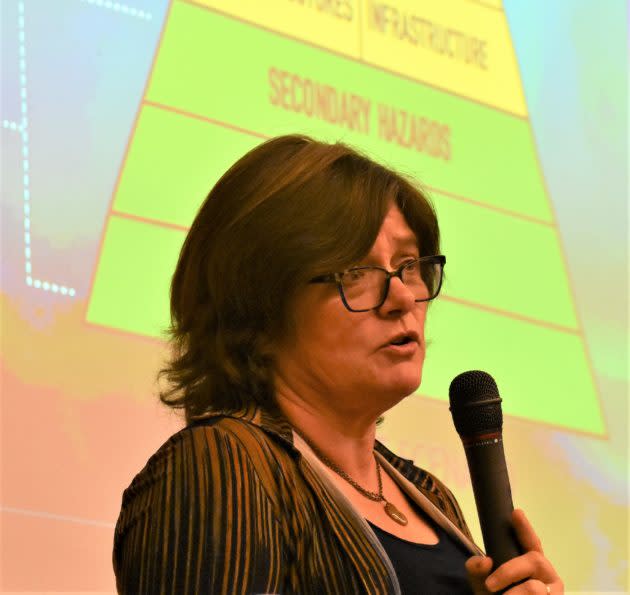Star seismologist Lucy Jones sizes up Seattle’s readiness for ‘the Really Big One’

When it comes to taking earthquakes seriously, Seattle’s problem may be that the city doesn’t get enough of them.
That’s one way of putting the assessment from Lucy Jones, a pioneering seismologist from Southern California who’s been called the “Beyoncé of Earthquakes.”
She earned that title by dint of decades’ worth of research and outreach at Caltech and the U.S. Geological Survey, particularly in her role as a risk reduction planner and the lead developer of the “Great ShakeOut” earthquake preparedness drill.
Since her retirement from USGS in 2016, Jones has been focusing on ramping up her own institute, the Dr. Lucy Jones Center for Science and Society, and writing a soon-to-be-published book titled “The Big Ones: How Natural Disasters Have Shaped Us.”
This week she came to Seattle to give talks at City Hall and at the University of Washington, recapping her work on Los Angeles’ “Resilience by Design” program.
Her work in L.A. has contributed to strengthening construction codes and raising public awareness for a “pay-now-rather-than-later” approach to retrofitting buildings. One of the big decisions to come out of the process was a plan for beefing up old concrete structures and “soft story” apartment buildings.
Jones said she found that preparedness is an easier sell if civic leaders can think not only about how to deal with the immediate aftermath of an earthquake, but also about how to keep their cities running long after the earth stops shaking.
“By emphasizing financial outcomes rather than life safety outcomes, we kept people away from the fear that makes them not want to think about it,” Jones explained. “It became a discussion of, ‘When do you want to spend this money? Do you spend the money before, or do you spend after?'”
Llke California, the Pacific Northwest has a potential earthquake problem — largely due to the offshore Cascadia Fault that has the potential to produce a devastating magnitude-9 earthquake and tsunami.
Exactly how devastating? Jones said it’s possible to overestimate the threat.
For example, a New Yorker article titled “The Really Big One” caused a scare in 2015 by stating that a Cascadia quake could turn everything west of Interstate 5 to toast. The way Jones sees it, the worst-case scenario for California’s San Andreas Fault would be worse than a worst-case Cascadia quake, in part because the San Andreas fault runs right through a heavily populated area rather than offshore.
But it’s also possible to underestimate the threat, and Jones suspects that’s more likely to be the case for folks in the Pacific Northwest than for Californians.
Even in L.A., it was a struggle to get policymakers, businesses and building owners on board with retrofitting and the “Resilience by Design” program, Jones said.
“You’ve got the same issue, and you’ve got to deal with it with less earthquakes,” she told the Seattle crowd. “Until this program, every significant seismic legislation in California has happened after we killed people in an earthquake. So that just puts you at a horrible disadvantage, because you’ve got a really big earthquake [to come] with a lot less smaller ones to help motivate you along the way.”
For year, experts have been recommending measures to force retrofits for more than 1,100 unreinforced brick and stone buildings in Seattle, plus thousands of buildings elsewhere in Washington state. Those recommendations, however, are still stuck in legislative limbo.
Will it take a Really Big One to spur action? Jones is hopeful that Seattle, and other cities facing unseen earthquake risks, can learn from the misfortunes of others in an increasingly connected world.
“For you guys to hear, ‘OK, we’ve got an earthquake and tsunami risk’ … what does that really mean?” Jones said. “You can go and watch what happened in Japan in 2011 and know what it means. That gives you a story. It gives you an emotional connection. It makes it more worthwhile moving on that.”
Worried about the Really Big One? Check out preparedness tips from Pacific Northwest earthquake experts, and from Washington state’s Emergency Management Division. Just this month, a report from Oregon provided a fresh assessment of the Cascadia earthquake risk.
Lucy Jones will be coming back to the Seattle area on April 24 for a presentation and book signing tied to “The Big Ones.” The event will be at Third Place Books in Lake Forest Park — which, for the record, is east of Interstate 5.
More from GeekWire:
Simulations show how major 9.0 earthquake could impact Northwest — and what Seattle should fear
Trump budget puts ShakeAlert earthquake warning system on shaky ground
UW gets in on $4.9 million boost for ShakeAlert earthquake warning system
Beast Quake 3? If Seahawks fans roar against Lions, seismologists set to monitor the rumble
